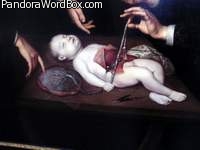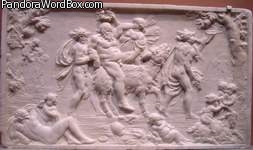While other overviews dealt with ESOPHAGUS, STOMACH, GASTRIC, ABDOMEN, and VENTRAL, this overview is about a large abdomen, belly, or below.
According to some authorities, BELLY arose from "bely", which is one of the most ancient English words. This popular term, as well as GUT, are considered to be somewhat coarse. In any case, BELLY conveys ideas linked with BELOW, BELLOW, BAG, BULGE, and BUDGET.
Ideas in cardinal words transcend any given language. Other tongues point out that BELLY has to do with BELCH, BARK, and VOICE. Notably, laryngeal cancer victims, who lose their vocal cords, can sustain some ability to verbalize by mastering the ability to BELCH gastric gas through the oral cavity.
Often, obesity has an early start.
The equivalent of "belly" in Spanish is VIENTRE, pointing to VIENTO for wind and to VENTRILOQUIST and VENTILATE. It is a fact that the VENTRAL cavity is like a bellow or a VENTOSE bag of winds that should not be VENTILATED in polite company.
Another point in "belly" is that at its center is the "OMPHALON", "UMBILICUS", or "NAVEL". In early embryos, what is "central" and "anterior" is marked by the "omphalon" or the "center of a thing". This term can be used to denote the "center" of any number of "things including the "NAVEL" orange as well as the center of the universe as marked by the "omphalon" stone in Delphi. The archaic nature of these ideas is underscored by the Sanskrit and old Germanic words NABHI and NABIS, found in NAVEL, all pointing to "the center of a thing". It is not surprising that the umbilicus is "central" in some religious traditions because it is clear that the omphalon, or navel, play a central role in the flow of energy from the mother (thus the universe) to the creation of a new "being". Where the omphalon is malformed, an OMPHALOCELE may result, a rather serious BIRTH DEFECT. GASTROSCHISIS is another sort of abdominal wall gap that can be confused with an omphalocele.
Central insertions of the umbilical cord anchoring a fetus to the placenta.
Note: a "wheel like" morphology of the .placenta with the cord at the center.A bulging "belly" can resemble a BARREL or containers used to "BEAR" or transport food and wine. BARRIGA, or belly in Spanish, points to BARRIL. These ideas and terms are more ancient than Rome or the Latin language.
Some deities had barrel like bellies.
As people accumulate FAT they become rotund or rounded. The GUT or BELLY are among the first to BUD, SWELL or BULGE. Notably, the Greek roots for swelling are PHALLOS and PHALLUS, as well as PHULLON, for a budding leaf. Another sphere is the propensity of penile organs to swell and become phallic-like.
Note that BELLY also links with BELL, BELLE, and BELLOW. In contrast to bells, which are crafted to generate beautiful, hollow sounds, BELLOWS, BELLOWING, and BELCHING tend to generate noise.
Formerly, obesity was ridiculed.
Finally, the vernacular "belly" was introduced as a respectable medical term by Dr. W. Osler, a famous American medical pioneer. Osler described the PRUNE BELLY SYNDROME, which is a very serious BIRTH DEFECT. Osler noted that many infants with a lax and protuberant abdomen had a disruption of abdominal musculature caused by greatly distended urinary bladders. The bladders were distended mostly because of a malformed male urethra that prevented normal voiding or urination. The disorder is seen in males and is rather rare. It occurs in about 1 of 30000 male births.
Additional vistas concerning the above may be found by exploring other illustrated overviews concerned with GARGLE, GARGOYLE, GLUTTON , GORGE , GOURMET, GULLET, LARYNX, LICK, LIP, LIVER, NUTRITION, NURTURE, OBESITY, PHARYNX, SALIVA, SPITTLE, SWALLOW, SUCK, THROAT, TONGUE, and VOICE.














